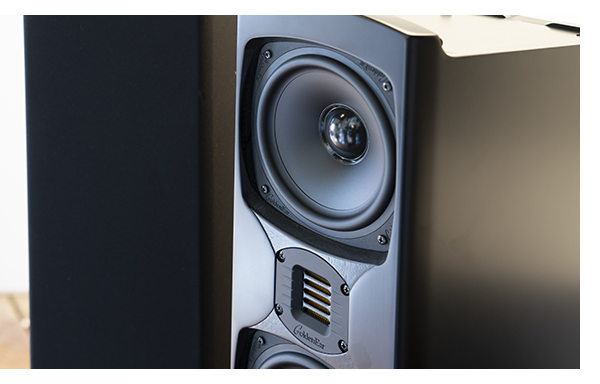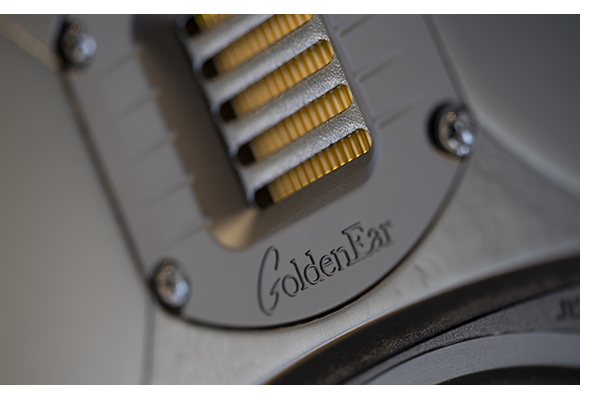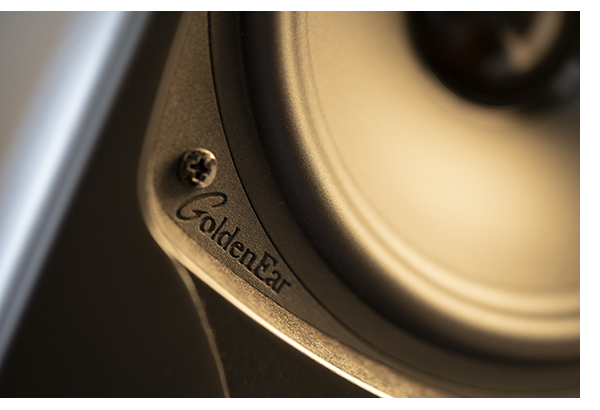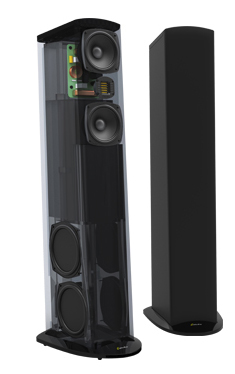The GoldenEar Triton Five Speakers
 If you’ve ever experienced a set of GoldenEar speakers, you know that their founder and head concept guru Sandy Gross is a master of great sound without breaking the bank. And for a good reason, he’s a music and hifi guy to the core, with decades of experience.
If you’ve ever experienced a set of GoldenEar speakers, you know that their founder and head concept guru Sandy Gross is a master of great sound without breaking the bank. And for a good reason, he’s a music and hifi guy to the core, with decades of experience.
Where the top speakers in the Triton range include powered woofers, the Triton Five is an entirely passive design, taking advantage of a pair of 6-inch drivers coupled to four side-firing 8-inch passive radiators. As with all Tritons, the Fives have a slender form factor, making them incredibly easy to integrate into your listening space. A 90 db/1-watt sensitivity means that they are equally easy to integrate into whatever gear you might be using.
The GoldenEar site claims that the Triton Fives “deliver exceptional performance with moderately priced receivers while allowing you to appreciate the subtle qualities of the world’s finest audio components.” We’ve been listening to the Fives for some time now, and have had the opportunity to audition them with an extensive range of components from vintage receivers to components costing 100 times the $1099.99 (each) price of these speakers.
 The short story? They pass with flying colors.
The short story? They pass with flying colors.
Utilizing the same HVFR (High-Velocity Folded Ribbon) tweeter as their top speakers, the Fives have much in common with the $10k/pair Triton REF speakers. Because the Triton REF speakers are more prominent, with larger LF drivers, and a built-in powered subwoofers, they move more air and have more dynamic capability. But at less than concert hall levels, the Triton Fives share a core sound with the REFs. The primary voice, transparency, and colossal soundstage you love in the Triton REF is just here to less of a degree. That’s a pretty amazing feat of engineering for slightly over $2k/pair.
The Fives join a concise list of speakers that deliver a vast look at money no object performance at a very agreeable price. These are speakers that you can build an incredible system around without giving up your vacation plans.
Yes, there are a couple of mini-monitors at the 2-3k level that might offer a bit more midrange accuracy or more “pinpoint imaging,” but they are specialist speakers. The Triton Fives are a real full-range speaker that can fill your listening room and be the anchor to your system without a subwoofer.
Begin at the beginning
Knowing Sandy Gross shares my love for vintage audio, my listening begins in earnest with a Dynaco Stereo 70 that was recently restored by our buds at Gig Harbor Audio. This classic amplifier has a soft, inviting sound, and the resolution of the Triton Fives fleshes out this character. The presentation is big, spacious, warm, inviting, and slightly rolled off on top. It’s a ton of fun and a great place to start your hifi journey. A similar sonic experience is offered by the original PrimaLuna ProLogue One, as well as the current EVO 100. 30 watts per channel of tube power is all you need to get into the groove.
Switching to the new Prima Luna EVO 400 monoblocks and the Audio Research REF160Ms is a different story. There’s plenty of extension at both ends of the frequency range here. Sandy was using the big Prima Lunas at Axpona, and if you were there, you know how great that sounded. Putting some significant power behind these speakers shows off their high degree of resolution and imaging ability. With amplification that’s up to the task, the Triton Fives do a remarkable job clarifying and unscrambling slightly compressed recordings that you might have thought unlistenable. That’s the mark of a great speaker at any price, but pretty much unheard of at two grand a pair.
 The GoldenEar site says you can enjoy the Fives with a basic receiver, and that’s true. These are some of the most amplifier friendly speakers we’ve spent time with. However, we’d suggest going for quality over quantity. We had incredibly great results with the $2,400 Sugden A21SE integrated, which is about 40 watts per channel. But it’s all power supply and is single-ended class-A.
The GoldenEar site says you can enjoy the Fives with a basic receiver, and that’s true. These are some of the most amplifier friendly speakers we’ve spent time with. However, we’d suggest going for quality over quantity. We had incredibly great results with the $2,400 Sugden A21SE integrated, which is about 40 watts per channel. But it’s all power supply and is single-ended class-A.
Tracking through Rick Springfield’s “That’s When I Found You” sounds like a big, unintelligible ball of sound on my LS-50s, yet through the Titan Fives, there’s a wealth of information that wasn’t coming through. Switching to something better recorded, with a much larger soundstage (in this case, The Police’s “Tea in the Sahara”), is expansive, with the speakers vanishing in the room. Again, this is what high-performance audio is all about, and it’s well within your reach. A beginning to end listening of Synchronicity is enlightening, the Fives creating a soundfield that extends well beyond the speaker boundaries, with plenty of height information as well as the other two dimensions. And if you really want to hear some treble clarity, wait for the bell in Queen’s “Bicycle Race.” Awesome – it sounds like there’s a vintage Schwinn right there in your listening room.
Easy to optimize
Thanks to their narrow front baffles, and broad horizontal dispersion, GoldenEar speakers are always easy to set up, even for the uninitiated. Ironically, you don’t have to be a “Golden Ear” to get them 90% of the way, yet an hour or so of fine-tuning, should you be so inclined will offer benefits in imaging and spatial placement.
The Triton Fives didn’t take a ton of time to break in, they sound great out of the box (and fortunately they are not terribly heavy, so one person can set them up) and benefit from about 50-100 hours of play at a moderate level. A little less if you’re playing a lot of bass-heavy program material. At that point, they lose a touch of mid-bass fog and really deliver the goods. You might want to consider doing a rough set up, and then after a week or so, really spending an afternoon making the final adjustment.
I followed Sandy’s lead, placing the Fives about 12 feet apart in my 16 x 25-foot listening room on the long wall. Experimenting with the long and short wall, I preferred the long wall, with them toed in a little bit more than usual. This offered a really spacious sound, and I am biased towards an immersive soundstage. So, if you’ve got the room, spread the Fives out until they separate into two mono speakers, and then pull them back together about 6-12 inches. That should have you in the ballpark.
Everyone who’s experienced the GoldenEar Triton Fives is thrilled with them, so add us to the list. This is a high-end speaker with a budget price tag because the designer has made the right choices. The cabinets are functional and only come in one finish – gloss black with a fabric front. One SKU means a massive scale of economy. Looking closer, you see the deceptively simple cabinets have a curved shape with no even surfaces to create cabinet resonances.
Basic black goes with everything and makes for an elegant speaker that has had the budget spent on sound quality. And that earns the Triton Fives a spot on our Product of the Year awards list at The Audiophile Apartment. Great sound, great value, great price.




